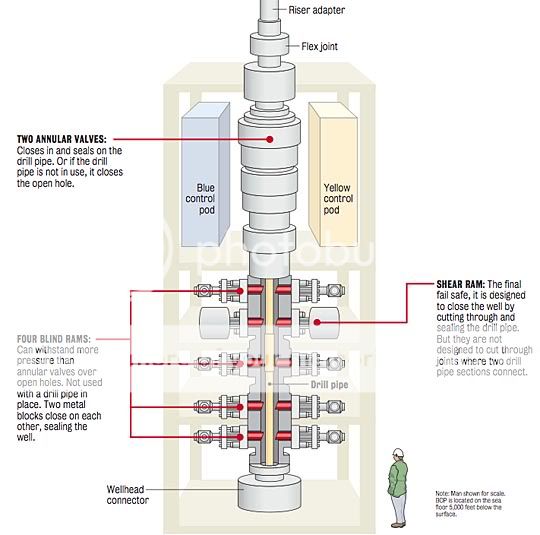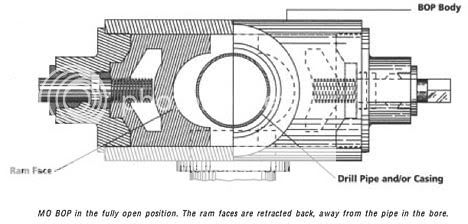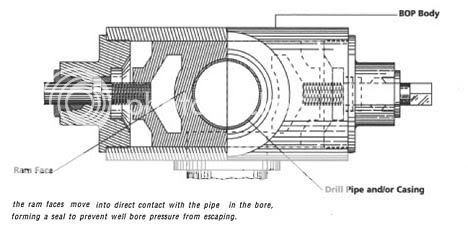Centralizers
Centralizers are attachments that go around the casing as it being lowered into the well to keep the casing in the center of the borehole. If the well is not properly centered prior to the cementing process, there is increased risk that channels will form in the cement that allow gas to flow up the annular space around the casing. API Recommended Practice 65 explains: "If casing is not centralized, it may lay near or against the borehole wall. ... It is difficult, if not impossible, to displace mud effectively from the narrow side of the annulus if casing is poorly centralized. This results in bypassed mud channels and inability to achieve zonal isolation."
On April 15, BP informed Halliburton's Account Representative, Jesse Gagliano, that BP was planning to use six centralizers on the final casing string at the Macondo well. Mr. Gagliano spent that day running a computer analysis of a number of cement design scenarios to determine how many centralizers would be necessary to prevent channeling. With ten centralizers, the modeling resulted in a "MODERATE" gas flow problem. Mr. Gagliano's modeling showed that it would require 21 centralizers to achieve only a "MINOR" gas flow problem.
Mr. Gagliano informed BP of these results and recommended the use of 21 centralizers. After running a model with ten centralizers, Mr. Gagliano e-mailed Brian Morel, BP's drilling engineer, and other BP officials, stating that the model "now shows the cement channeling" and that ''I'm going to run a few scenarios to see if adding more centralizers will help us or not. Twenty-five minutes later, Mr. Morel e-mailed back:
We have 6 centralizers, we can run them in a row, spread out, or any combination of the two. It's a vertical hole, so hopefully the pipe stays centralized due to gravity. As far as changes, it's too late to get any more product on the rig, our only option is to rearrange placement of these centralizers.
The following day, April 16, the issue was elevated to John Guide, BP's Well Team Leader, by Gregory Walz, BP's Drilling Engineering Team Leader. Mr. Walz informed Mr. Guide: "We have located 15 Weatherford centralizers with stop collars ... in Houston and worked things out with the rig to be able to fly them out in the morning." The decision was made because "we need to honor the modeling to be consistent with our previous decisions to go with the long string." Mr. Walz explained: "I wanted to make sure that we did not have a repeat of the last Atlantis job with questionable centralizers going into the hole." Mr. Walz added: "I do not like or want to disrupt your operations . ... I know the planning has been lagging behind the operations and I have to turn that around."
In his response, Mr. Guide raised objections to the use of the additional centralizers, writing: "it will take 10 hrs to install them . ... I do not like this and ... I [am] very concerned about using them."
An e-mail from Brett Cocales, BP's Operations Drilling Engineer, indicates that Mr. Guide's perspective prevailed. On April 16, he e-mailed Mr. Morel:
Even if the hole is perfectly straight, a straight piece of pipe even in tension will not seek the perfect center of the hole unless it has something to centralize it.
But, who cares, it's done, end of story, will probably be fine and we' ll get a good cement job. I would rather have to squeeze than get stuck .... So Guide is right on the risk/reward equation.
On April 17, Mr. Gagliano, the Halliblllton account representative, was informed that BP had decided to use only six centralizers. He then ran a model using seven centralizers and found this would likely produce channeling and a failure of the cement job. His April 18 cementing design report states: "well is considered to have a SEVERE gas flow problem."
Mr. Gagliano said that BP was aware of the risks and proceeded with knowledge that his report indicated the well would have a severe gas flow problem.
Mr. Gagliano's findings should not have been a surprise to BP. As noted above, BP's mid-April plan review found that if BP used a single string of casing, as BP had decided to do, "Cement simulations indicate it is unlikely to be a successful cement job." Nonetheless, BP ran the last casing with only six centralizers.
Cement Bond Log
A cement bond log is an acoustic test that is conducted by running a tool inside the casing after the cementing is completed. The cement bond log determines whether the cement has bonded to the casing and surrounding formations. If a channel that would allow gas flow is found, the casing can be perforated and additional cement injected into the annular space to repair the cement job.
Mr. Roth, the Halliburton Vice President of Cementing, informed the Committee staff that BP should have conducted a cement bond log. According to Mr. Roth, "If the cement is to be relied upon as an effective barrier, the well owner must perform a cement evaluation as part of a comprehensive systems integrity test. Minerals Management Service (MMS) regulations also appear to direct a cement bond log or equivalent test at the Macondo well. According to the regulations, if there is an indication of an inadequate cement job, the oil company must "(1) Pressure test the casing shoe; (2) Run a temperature survey; (3) Run a cement bond log; or (4) Use a combination of these techniques."
In the case of the Macondo well, the Halliburton and internal BP warnings should have served as an indication of a potentially inadequate cement job.
On April 18, BP flew a crew from Schlumberger to the rig. As described in a Schlumberger timeline, "BP contracted with Schlumberger to be available to perform a cement bond log ... should BP request those services. But at about 7:00 a.m. on the morning of April 20, BP told the Schlumberger crew that their services would not be required for a cement bond log test. As a result, the Schlumberger crew departed the Deepwater Horizon at approximately 11:15 a.m. on a regularly scheduled BP helicopter flight. The Schlumberger crew was scheduled for departure before pressure testing of the well had been completed, indicating that the results of those tests were not a factor in BP's decision to send the crew away without conducting a cement bond log.
BP's decision not to conduct the cement bond log test may have been driven by concerns about expense and time. The cement bond log would have cost the company over $128,000 to complete. In comparison, the cost of canceling the service was just $10,000.45 Moreover, Mr. Roth of Halliburton estimated that conducting the test would have taken an additional 9 to 12 hours. Remediating any problems found with the cementing job would have taken still more time.
The Committee staff asked an independent engineer with expertise in the analysis of well failure about BP's decision not to conduct a cement bond log. The engineer, Gordon Aaker, Jr., P.E., a Failure Analysis Consultant with the firm Engineering Services, LLP, said that it was "unheard of" not to perform a cement bond log on a well using a single casing approach, and he described BP's decision not to conduct a cement bond log as "horribly negligent." Another independent expert consulted by the Committee, Jolm Martinez, P.E., told the committee that "cement bond or cement evaluation logs should always be used on the production string."
Mud Circulation
Another questionable decision by BP appears to have been the failure to circulate fully the drilling mud in the well before cementing. This procedure, known as "bottoms up," involves circulating drilling mud from the bottom of the well all the way to the surface. Bottoms up has several purposes: it allows workers on the rig to test the mud for influxes of gas; it permits a controlled release of gas pockets that may have entered the mud; and it ensures the removal of well cuttings and other debris from the bottom of the well, preventing contamination of the cement.
API's guidelines recommend a full bottoms up circulation between running the casing and beginning a cementing job. The recommended practice states that "when the casing is on bottom and before cementing, circulating the drilling fluid will break its gel strength, decrease its viscosity and increase its mobility. The drilling fluid should be conditioned until equilibrium is achieved .... At a minimum, the hole should be conditioned for cementing by circulating 1.5 annular volumes or one casing volume, whichever is greater."
BP's April 15 operations plan called for a full bottoms up procedure to "circulate at least one (I) casing and drill pipe capacity, if hole conditions allow." Halliburton Account Representative Jesse Gagliano said it was also "Halliburton's recommendation and best practice to at least circulate one bottoms up on the well before doing a cement job. " According to Mr. Gagliano, a Halliburton engineer on the rig raised the bottoms up issue with BP.
Despite the BP operations plan and the Halliburton recommendation, BP did not fully circulate the mud, Instead, it chose a procedure "written on the rig" which Mr. Gagliano "did not get input in. " BP's final procedure called for circulating just 261 barrels of mud, just a small fraction of the mud in the Macondo well. Mr. Roth of Halliburton told the Committee that one reason for the decision not to circulate the mud could have been a desire for speed, as fully circulating the mud could have added as much as 12 hours to the operation. Mr. Gagliano expressed a similar view, saying, "the well probably would not have handled too high of a rate, so it would take a little bit . . . longer than usual to circulate bottoms up in this case."
Lockdown Sleeve
A final question relates to BP's decision not to install a critical apparatus to lock the wellhead and the casing in the seal assembly at the seafloor. When the casing is placed in the wellhead and cemented in place, it is held in place by gravity. Under certain pressure conditions, however, the casing can become buoyant, rising up in the wellhead and potentially creating an opportunity for hydrocarbons to break through the wellhead seal and enter the riser to the surface. To prevent this, a casing hanger lockdown sleeve is installed. On June 8, 2010, Transocean briefed Committee staff on its investigation into the potential causes of the explosion on board the Deepwater Horizon. In the presentation, Transocean listed the lack of a lockdown sleeve as one of its "areas of investigation." Slide seven of Transocean's presentation asks: "Were Operator procedures appropriate?" A subpoint details: "Operator did not run lock down sleeve prior to negative test or displacement." Mr. Roth of Halliburton raised a similar concern in his June 3 briefing for Committee staff.
In BP's planned procedure for the well, BP describes two options involving the lockdown sleeve. BP was seeking permission from MMS to install the final cement plug on the well at a lower depth than previously approved. If permission was granted, BP's plan was to displace the drilling mud in the riser with seawater and install the cement plug prior to installation of the casing hanger lockdown sleeve. BP's alternative plan, if MMS did not approve the proposed depth of the final cement plug, was to run the lockdown sleeve first, before installing the cement plug at a shallower depth. On April 16, Brian Morel, BP's drilling engineer, e-mailed BP staff that: "We are still waiting for approval of the departure to set our surface plug . ... If we do not get this approved, the displacement plug will be completed shallower after running the LDS." The LDS stands for the lockdown sleeve.
Conclusion
The Committee's investigation into the causes of the blowout and explosion on the Deepwater Horizon rig is continuing. As our investigation proceeds, our understanding of what happened and the mistakes that were made will undoubtedly evolve and change. At this point in the investigation, however, the evidence before the Committee calls into question multiple decisions made by BP. Time after time, it appears that BP made decisions that increased the risk of a blowout to save the company time or expense. If this is what happened, BP's carelessness and complacency have inflicted a heavy toll on the Gulf, its inhabitants, and the workers on the rig.
During your testimony before the Committee, you will be asked about the issues raised in this letter. This will provide you an opportunity to respond to these concerns and clarify the record. We appreciate your willingness to appear and your cooperation in the Committee's investigation.
Sincerely,
Henry A. Waxman
Chairman
Bart Stupak
Chairman
Subcommittee on Oversight and Investigations





